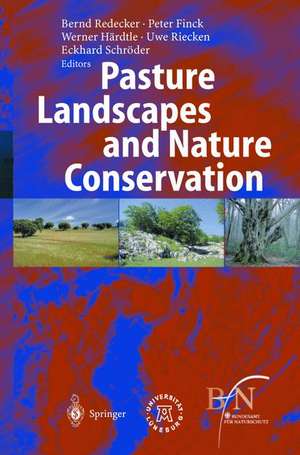Pasture Landscapes and Nature Conservation
Editat de Bernd Redecker, Werner Härdtle, Peter Finck, Uwe Riecken, Eckhard Schröderen Limba Engleză Hardback – 28 mai 2002
| Toate formatele și edițiile | Preț | Express |
|---|---|---|
| Paperback (1) | 648.42 lei 6-8 săpt. | |
| Springer Berlin, Heidelberg – 17 aug 2012 | 648.42 lei 6-8 săpt. | |
| Hardback (1) | 660.04 lei 6-8 săpt. | |
| Springer Berlin, Heidelberg – 28 mai 2002 | 660.04 lei 6-8 săpt. |
Preț: 660.04 lei
Preț vechi: 776.52 lei
-15% Nou
Puncte Express: 990
Preț estimativ în valută:
126.30€ • 131.61$ • 104.57£
126.30€ • 131.61$ • 104.57£
Carte tipărită la comandă
Livrare economică 03-17 aprilie
Preluare comenzi: 021 569.72.76
Specificații
ISBN-13: 9783540429203
ISBN-10: 3540429204
Pagini: 460
Ilustrații: XXII, 435 p.
Dimensiuni: 155 x 235 x 30 mm
Greutate: 0.96 kg
Ediția:2002
Editura: Springer Berlin, Heidelberg
Colecția Springer
Locul publicării:Berlin, Heidelberg, Germany
ISBN-10: 3540429204
Pagini: 460
Ilustrații: XXII, 435 p.
Dimensiuni: 155 x 235 x 30 mm
Greutate: 0.96 kg
Ediția:2002
Editura: Springer Berlin, Heidelberg
Colecția Springer
Locul publicării:Berlin, Heidelberg, Germany
Public țintă
ResearchCuprins
I. Introduction.- Pasture Landscapes and Nature Conservation - New strategies for preservation of open landscapes in Europe.- Nature conservation in pastoral landscapes: Challenges, chances and constraints.- II. Grazing as a phenomenon in Europe.- Nature conservation and pastoralism in Wallony.- Stipa austroitalica garigues and mountain pastureland in the Pollino National Park (Calabria, Southern Italy).- Landscapes of northern Spain and pastoral systems.- Nature conservation aspects of pastoral farming in Georgia.- Grazing systems and their influence on biodiversity in the region of the Dnister river.- Managing wood pasture landscapes in England; the New Forest and other more recent examples.- The role of invisible biodiversity in pasture landscapes.- III. Grazing as a Nature Conservation strategy.- Pasture landscapes in Germany - progress towards sustainable use of agricultural land.- Maintaining biodiversity and open landscapes by grazing in the County of South Jutland, Denmark.- Nature development along the river Scheldt: Combining ecosystem functions in the Kruibeke-Bazel-Rumpelmonde polder.- The Border Meuse Nature Development Project.- The Lake Pape: Grazing of coastal grasslands. WWF Latvia project.- Galloway-based grazing systems in Schleswig-Holstein (Germany) - projects run by BUNDE WISCHEN e. V. association.- Low intensity pig pastures as an alternative approach for habitat management.- The Eidertal pasture landscape - Mire restoration and species conservation in a river valley of Schleswig-Holstein (northwest Germany).- Inland Sand Ecosystems: Dynamics and restitution as a consequence of the use of different grazing systems.- Management concepts for abondoned xerothermic slopes in the middle Rhine Valley: A case study in the sustainable development of cultural landscapes.- Examples of the maintenance and restoration of wood pasture sites in the UK and the potential for creation.- Grasslands and scrublands in the northwest of the Iberian Peninsula: Silvopastoral systemy and nature conservation.- Landscape development and species protection in woodlands, forests and pastures using large herbivores.- The Large Herbivore Initiative: An Eurasian conservation and restoration programme for a key-species group in ecosystems (Europe, Russia, Central-Asia and Mongolia).- Urbanized man and the longing for a New Wilderness.- The significance of EU agricultural policy on the nature conservation of pastoral farmland.- IV. Grazing and habitat dynamics - results of scientific research.- Methods for the investigation of patterns and processes in large-scale grazing systems.- Effects of large-scale cattle grazing on Orthoptrea (Saltatoria et Mantodea) on pastures in Georgia (Caucasus).- Does large-scale, multi-species pasturing maintain high biodiversity with rare and endangered species? - The Sava floodplain case study.- Large-scale grazing systems by herdsmen and their impact on landscape patterns and biodiversity in western Ukraine’s Carpathians.-Co-operative grazing systems (“Allmende”): An alternative concept for the management of endangered open and semi-open landscapes.- MOSAIK: Semi-open pasture and ley - a research project on keeping the culural landscape open.- Natural succession in a dynamic riverine landscape and the protection of open areas.- V. Outlook.- Significance of pasture landscapes for nature conservation and extensive agriculture.
Recenzii
“The book is a series of studies on vegetation of pastures, and certainly the field botanist or environmental scientist concerned with these ecosystems or interested in their conservation will find a wealth of rich material. It provides readers with a vivid picture of the environmental, social and political changes that pastoral societies face in different regions. … From an academic perspective, this book further develops the field of social-ecological theory and resilience thinking by systematically connecting theories with management practices.” (Khalid Hussain and Tasadoq Hussain Jaweed, Pastoralism, December, 2017)
Textul de pe ultima copertă
Numerous European landscapes and habitats - both natural and cultural - developed and persisted through the activities of large herbivores. In many cases these landscapes were characterized originally by a high level of biodiversity and are therefore of extraordinary importance from a nature conservation perspective. However, due to the ongoing intensification and industrialization of agricultural land use during the past decades, species and habitats - especially those of open and semi-open areas - have become increasingly endangered. Furthermore, the remaining more extensively used sites are at risk of abandonment. In several European countries the establishment and preservation of "pasture landscapes" with a mixed character of open grassland, shrubs and forests has been recognized as a suitable strategy, offering solutions for both nature conservation and traditional farming systems. In response to the need to exchange ideas and experiences on a European level, the University of Lüneburg and the German Federal Agency for Nature Conservation organized the 1st International Workshop on Pasture Landscapes and Nature Conservation in March 2001. The resulting proceedings provide an overview of the importance of existing pastoral systems, nature conservation policies and strategies and present the results of scientific research and practical experience with large-scale grazing systems.














